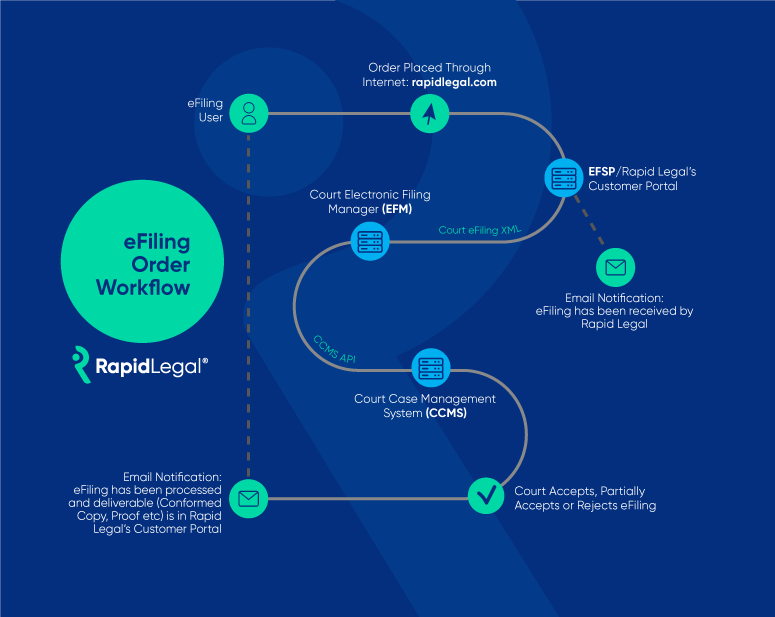Most of us in the legal industry are familiar with, or have at least heard of, “eFiling”, but have you heard of “eDelivery or eSubmit”? More importantly, do you know the difference?
Before we dive into what eDelivery/eSubmit is, it’s important to understand some of the history of how legal documents have been transmitted to U.S. courts throughout the years.
Prior to the digital age, court submissions were done in one of two ways: 1) legal documents were physically filed at the court and 2) they were sent via mail. Later, with the introduction of the fax machine in the 1990’s, fax filing was born. This changed the speed and ease of how documents could be transmitted.
With fax filing, a user would send their legal documents to a Fax Filing Service Provider who would review, prepare, and physically deliver the documents directly to the court or transmit the documents via facsimile to the court. All three of these traditional methods, each with their own advantages and disadvantages, are still being utilized today. The other two methods are eDelivery/eSubmit and eFile, which we will cover a little later.
Methods to File Documents with the Court:

People Still Use the Fax!?!
Believe it or not, there are a number of reasons why we are still using the fax machine in 2020. The fact is, we don’t know if it’s going away anytime soon due to user familiarity, ease of use, and legacy requirements. But it isn’t a method without flaws. What a user may not know is that once a fax transmission is received by the court, there is an entire manual workflow that takes place behind the scenes by court personnel and the timeline varies by each court.
For example, once the fax is received, a court clerk has to manually check the documents for accuracy and completeness, accept them or reject them due to errors, and then manually input them into the Court’s Case Management System (CCMS). This manual effort takes time, is subject to delays due to data entry or workflow bottlenecks and can result in human error. Thus, eFiling and eDelivery/eSubmit were introduced to solve these shortcomings.

What is Electronic Filing (eFiling)?
Electronic filing, or eFiling, is the method of electronically submitting your legal documents to the court via the internet. It typically requires the user to select an approved eFiling Service Provider (EFSP) to eFile their legal documents. Federal, state, and municipal courts have varying rules and regulations for eFiled documents. In many courts, electronic filing is mandatory and they do not allow in-person physical filing.
The biggest advantages of eFiling over traditional filing methods are that it is significantly faster to process, it reduces the amount of paper/manual processes and it’s much more cost-effective, i.e., a physical filing costs $65+ vs. $10 for an eFiling. Traditional filing meant that law firms needed to have a court runner to deliver multiple paper copies of legal documents and pleadings to the corresponding courts and parties.
eFiling is a truly integrated, end-to-end data exchange solution, connecting law firms and EFSPs directly to the courts. This diagram gives a high-level overview of how eFiling works:

Currently, 36 out of 58 counties in California have enabled some level of eFiling in their courts. Starting in 2008, many individual county courts in California such as Orange County, Contra Costa, and Sacramento had begun piloting programs for eFiling.
Because eFiling is a fully-integrated technology solution, the cost/investment, time and expertise needed is significant for the court. Some county courts also don’t have the case volume to justify such an investment. Bear in mind that fax submissions at this point are still actively being used, likely suppressing the need to modernize and go fully digital. Thus, for courts that don’t have the budget, expertise or infrastructure to support eFiling, a new solution called “eDelivery” was developed.
What is eDelivery?
More recently, some county courts that were not ready to make the full transition to eFiling have implemented an interim solution called “eDelivery”. Essentially, a platform – or web portal – allows parties the ability to submit electronic (PDF) versions of documents in place of the original directly to individual courts, similar to how fax filing works.
How Does it Work?
- Electronic (PDF) versions of documents will be submitted by the filing party through a web portal
- Upon receiving electronic document(s), a “Notice of Receipt of Documents” will be sent to the email address provided by the user
- This notice will contain the eDelivery submission number and will confirm that the Court has received the document(s)
- Provided the information supplied is complete and the fees paid are correct, the document(s) will be accepted by the Court and will be filed with the appropriate courthouse as if it had been filed in person
- Upon the acceptance of the document, an email notifying the submitting party of such, along with an electronic conformed copy, will be sent
- A notifying email will also be sent if the document is rejected
Considerations/Limitations
- Not a fully-integrated, automated solution
- Like fax filing, it still requires court clerk to manually input into court case management system
- Speed – receipt of filing is dependent on court
- Separate logins per court
- Fees may vary and a credit card is required for each filing
- Credit card is the only accepted method of payment
So far, four county courts in California are using an “eDelivery” solution: Imperial, Placer, San Joaquin, and Riverside. The latter two mentioned, San Joaquin and Riverside, have implemented their own instance of eDelivery portals. It is important to note, to avoid confusion, that although San Joaquin calls it “eFile” on their portal, that it is essentially an eDelivery portal. Riverside, on the other hand, refers to their portal as “eSubmit” so you might see these two terms used together or synonymously.
eFile vs. eDelivery/eSubmit
Although the terminology may sound similar, eFile vs. eDelivery/eSubmit are completely different processes as the latter is not a fully integrated solution and there is no data-exchange taking place. Essentially, eDelivery/eSubmit is really just a step above fax filing. With eDelivery/eSubmit, once the court receives the submission, the process is essentially the same as fax. A clerk will still need to review the documents, accept or reject, then manually input the information from the PDF into the court case management system.
To help compare some of the other differences between eFile vs. eDelivery/eSubmit, please refer to this chart below:
| Feature | eFile | eDelivery/eSubmit |
|---|---|---|
| PDF delivery of documents to Court’s Case Management system | Yes | Yes* |
| Receipt of Filing | Within minutes | Usually within 2 business days |
| Integrates with court policies | Yes | No* |
| Single log-in | Yes | No; separate login per court |
| Email notifications | Yes | Yes |
| Fees | An electronic filing service provider (EFSP) pays all fees in advance and sends a single itemized invoice at the end of each transaction | Varies (depending on court, usually convenience fee + credit card processing fee). A credit card is required for each filing |
| Payment Methods | Credit card, eCheck/ACH | Credit card only |
| *Requires court clerk to input into court case management system | ||
Which Courts in California offer eFiling or eDelivery/eSubmit?
| County | eFile | eDelivery/eSubmit | Physical Filing-only |
|---|---|---|---|
| Alameda | ✔ | ✔ | |
| Alpine | ✔ | ||
| Amador | ✔ | ||
| Butte | ✔ | ||
| Calaveras | ✔ | ||
| Colusa | ✔ | ||
| Contra Costa | ✔ | ✔ | |
| Del Norte | ✔ | ||
| El Dorado | ✔ | ✔ | |
| Fresno | ✔ | ||
| Glenn | ✔ | ||
| Humboldt | ✔ | ||
| Imperial | ✔ | ✔ | |
| Inyo | ✔ | ||
| Kern | ✔ | ||
| Kings | ✔ | ||
| Lake | ✔ | ||
| Lassen | ✔ | ||
| Los Angeles | ✔ | ||
| Madera | ✔ | ✔ | |
| Marin | ✔ | ||
| Mariposa | ✔ | ✔ | |
| Mendocino | ✔ | ✔ | |
| Merced | ✔ | ||
| Modoc | ✔ | ||
| Mono | ✔ | ||
| Monterey | ✔ | ||
| Napa | ✔ | ||
| Nevada | ✔ | ✔ | |
| Orange | ✔ | ||
| Placer | ✔ | ✔ | |
| Plumas | ✔ | ||
| Riverside1 | ✔ | ✔ | |
| Sacramento | ✔ | ||
| San Benito | ✔ | ||
| San Bernardino | ✔ | ✔ | |
| San Diego | ✔ | ||
| San Francisco | ✔ | ||
| San Joaquin2 | ✔ | ||
| San Luis Obispo | ✔ | ||
| San Mateo | ✔ | ||
| Santa Barbara | ✔ | ||
| Santa Clara | ✔ | ||
| Santa Cruz | ✔ | ||
| Shasta | ✔ | ||
| Sierra | ✔ | ||
| Siskiyou | ✔ | ||
| Solano | ✔ | ||
| Sonoma | ✔ | ||
| Stanislaus | ✔ | ||
| Sutter | ✔ | ||
| Tehama | ✔ | ✔ | |
| Tuolumne | ✔ | ||
| Trinity | ✔ | ||
| Tulare | ✔ | ✔ | |
| Ventura | ✔ | ||
| Yolo | ✔ | ✔ | |
| Yuba | ✔ | ||
| 1 Riverside refers to their eDelivery portal as “eSubmit” 2 San Joaquin refers to their eDelivery service as “eFile” on their website | |||
Last update: June, 2023
Do you still have some questions on the difference between eFiling and eDelivery/eSubmit? Schedule a 15-minute call with a Rapid Legal Account Manager today – we’ll be happy to answer all your questions!
About Rapid Legal
For more than 25 years, Rapid Legal has helped to define and transform the legal support services industry with its vision and commitment to customers, the courts, and a party’s right to due process under the law.
Trusted by thousands of law firms, government agencies and companies, Rapid Legal leverages its deep industry and technology expertise, and a best-in-class legal services cloud management platform, LegalConnect®, for delivering premium legal support services including electronic filing of court documents (“eFiling”), physical court filings, and service of process.
